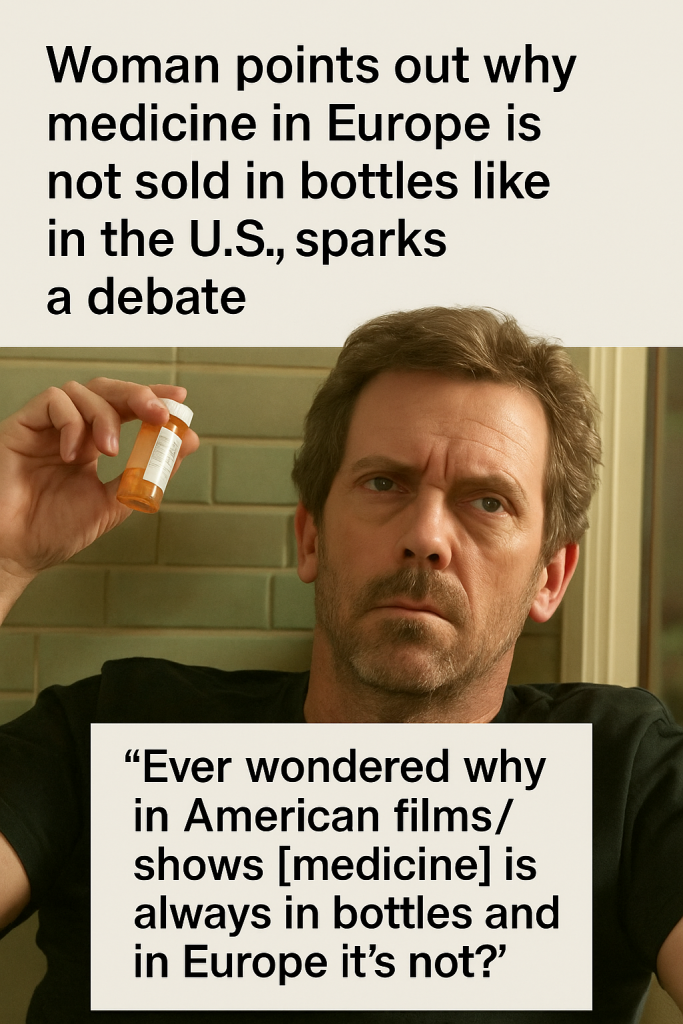A recent viral moment on social media has ignited a lively debate regarding a common yet often overlooked difference between European and American medicine packaging. A woman’s insightful explanation about why medicine in Europe is rarely sold in bottles, unlike in the United States, has resonated with millions and sparked an engaging conversation about healthcare systems, safety, and cultural practices around pharmaceuticals.
The discussion began when the woman posted an image comparing typical U.S. medicine bottles—often seen in American films and television shows—with the predominantly blister-packaged pills common in Europe. Accompanied by a clear, informative caption, she outlined the practical reasons behind Europe’s preference, addressing assumptions many made about convenience, safety, and pharmaceutical regulations.
The Key Difference: Packaging and Purpose
In the United States, medications, especially over-the-counter pills and supplements, frequently come in plastic bottles equipped with child-proof caps. These bottles allow for multiple doses taken over an extended period, giving users easy access to their medicine without opening individual portions. Conversely, in Europe, it is far more common for medicines to be packaged in blister packs or sealed individual doses.
The woman highlighted that blister packs serve not only as tamper-evident packaging but also help maintain the potency and freshness of each pill. Unlike bottles, which expose the entire supply to air, moisture, and contamination each time they are opened, blister packs protect every pill individually until it is consumed.
Public Health and Safety Considerations
Europe’s approach to packaging reflects stringent healthcare regulations aimed at minimizing risks associated with medication misuse and contamination. Blister packs make it easier to track dosing schedules and help prevent accidental overdoses by limiting the accessible quantity at any given time.
Moreover, this packaging style fits well within Europe’s broader healthcare ecosystem, which emphasizes monitored dispensing and often prescribes medications for shorter courses with precise dosages. Pharmacies frequently dispense exact amounts needed, reducing leftover pills and encouraging completion of prescribed treatment.
The U.S. Context and Consumer Preferences
In contrast, the U.S. market favors convenience, bulk purchasing, and cost-saving measures like buying larger quantities of medication at once. Plastic bottles facilitate this preference, granting consumers easier access to their medications over several weeks or months without frequent pharmacy visits. However, this practice raises concerns about medication adherence, accidental poisonings, and environmental waste.
The woman’s post prompted many to reflect on how cultural norms surrounding medicine affect patient behavior and public safety outcomes. Some social media users expressed surprise that their long-standing assumptions about medicine packaging were shaped primarily by film and television portrayals rather than practical factors.
A Broader Dialogue on Global Healthcare Practices
This viral conversation underscores how everyday objects—like a pill bottle—can reveal deeper insights into healthcare philosophies, regulatory environments, and societal values. It also invites a more nuanced understanding of how different regions tackle common challenges such as medication safety, compliance, and accessibility.
As the debate continues, experts stress that there is no one-size-fits-all solution. Each system balances safety, convenience, and cost differently. However, increased awareness and cross-cultural dialogue may inspire improvements in how medications are packaged and dispensed worldwide.
Ultimately, this social media moment is a reminder that even simple questions about everyday items can spark important discussions about health and well-being on a global scale.



